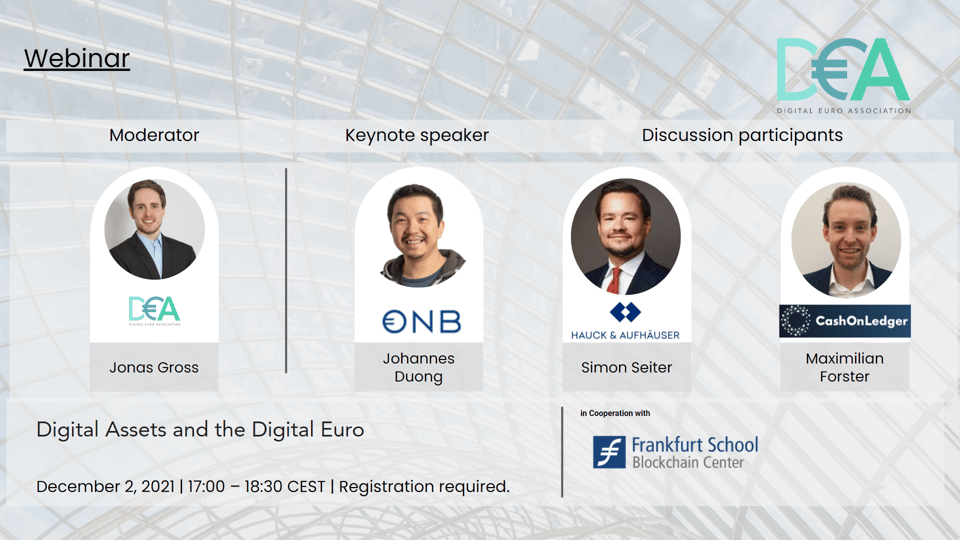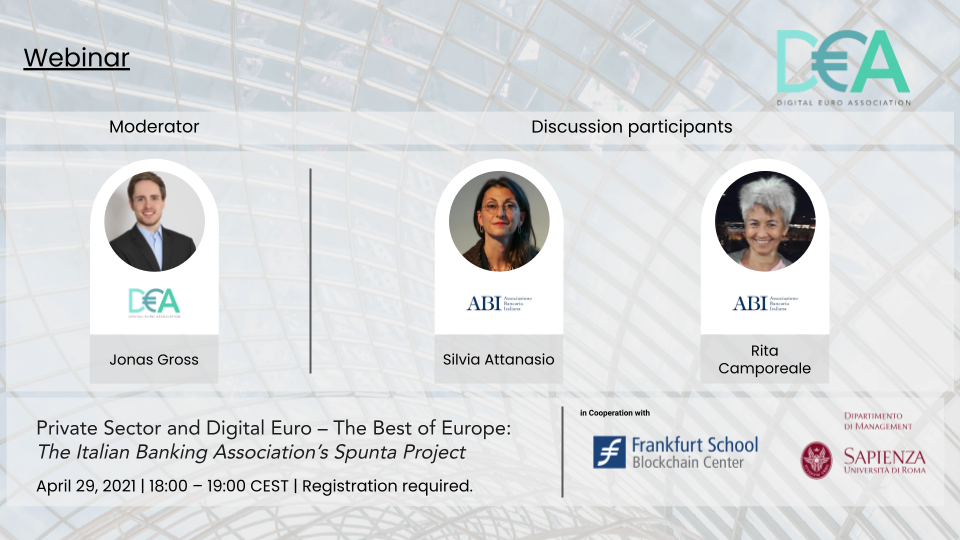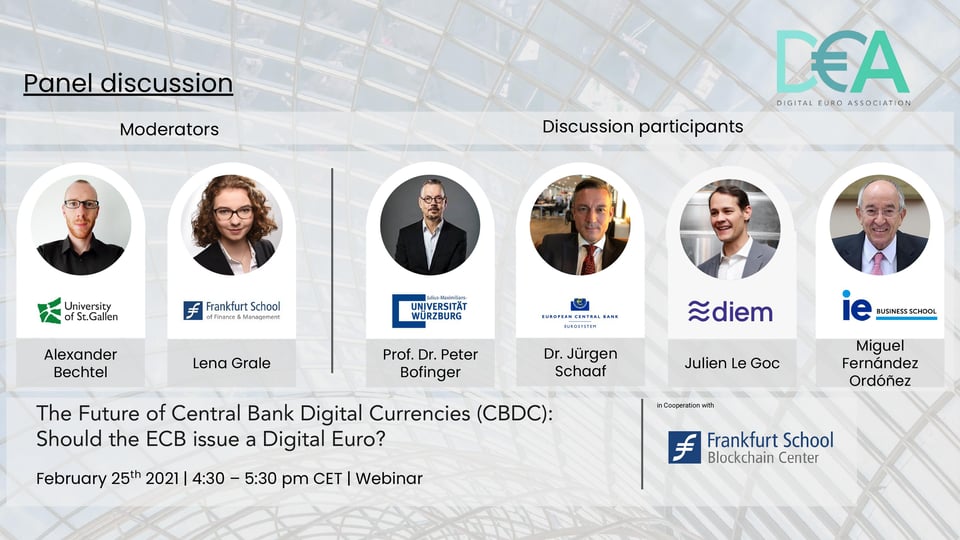Events
DEA online panels are exchanges amongst renown experts on digital money related topics.
Panel Formats

Techy Tuesday
Open tech discussion on a digital money-related topic, discussing technical questions, providing product walkthroughs or giving code examples.

Expert Panels
Discussion amongst experts on a particular topic, touching on current trends, assessing risks and potentials as well as giving an outlook on future trends and developments.
Wholesale CBDCs: Tomorrow’s Case for Payments and Securities Settlement
According to Fabio Panetta (Member of the Executive Board of the European Central Bank (ECB), the Eurosystem is committed to providing settlement in central bank money for wholesale transactions through infrastructures that are fit for purpose and seemingly also for a digitalizing financial world. News surrounding projects on the exchange and settlement of financial assets and transactions on Distributed Ledger Technologies (DLT) not just in the eurozone but rather worldwide have been densifying over the past years. While certain private company solutions offering cross-chain interoperability for simultaneous delivery and payment have already secured significant funding, the banking sector worldwide has also geared up to further explore central bank settled transactions with the likes of the DLT Pilot Regime in the eurozone, the DLT settlement project by the Australian Securities Exchange (ASX) and the advanced project Helvetia by the Swiss National Bank, to name just a few. According to the ECB, delivery versus payment transactions account for 72.66% of the entire settlement volume of the Target2 system in the eurozone, highlighting the need and challenge connected to finding a wholesale settlement solution fit for the 21st century.
The arising challenge is further complicated by the unprecedented need to settle securities by transferring account-based securities in exchange for cash tokens or transferring security tokens in exchange for cash in accounts. Not only do these cases require technical compatibility but also a sound regulatory environment in order to move from theory and sandbox environments into practice. A balancing act that is yet to be reached, as ongoing wholesale CBDC projects are currently at most in advanced proof-of-concept (PoC) phases due to these questions remaining unanswered until now.
The goal of this webinar is to discuss and assess the current wholesale CBDC landscape and their implications for cross-border security and payment settlement, factors currently preventing these projects from moving forward and unanswered paradigms such as cross-jurisdictional and technological interoperability.
In particular, in this webinar, we focus on addressing the following questions:
- Where do we stand with regards to wCBDC development worldwide?
- Should a wCBDC use DLT as an infrastructure? If yes, why would it be beneficial?
- What are the limiting factors for wCBDC projects currently in the PoC phase?
- How could a wCBDC landscape with different regulations work?
- How would wCBDC payments differ from current RTGS systems?
- Which technological approaches to interoperability are there?
- Which learnings does the DLT Pilot Regime offer?
- When can we expect wCBDC projects to move to a pilot or realization phase?
CBDCs and Privacy: Considerations for an International Landscape
Privacy, being a fundamental human right, holds significant importance in the investigation and development of Central Bank Digital Currencies (CBDCs). Preliminary evidence suggests that the level of privacy associated with CBDC use will greatly influence the adoption and usage of CBDCs. Currently, there is a perceived tradeoff between safeguarding users' privacy and ensuring compliance with various regulations and policies such as Anti-Money Laundering/Combating the Financing of Terrorism (AML/CFT).
However, it is important to note that this tradeoff is not a binary choice. By utilizing a range of privacy-enhancing techniques, each country has the opportunity to design a customized solution that achieves an optimal balance between these two objectives based on their specific needs and priorities.
Among the 130 countries currently exploring CBDCs, distinct values are emerging, with some placing higher importance on transactional anonymity for amounts below a certain threshold, guaranteeing complete irretrievability of associated data. Others prioritize centralization and traceability. For those countries seeking to achieve both maximum privacy and security, a combination of classical symmetric encryption with a Public Key Infrastructure (PKI) key exchange mechanism, advanced pseudonymization techniques, zero-knowledge proofs, and other cryptographic methods have been employed. As a key value driver for many countries exploring CBDC is their cross-border use and settlement, the need to address cross-jurisdictional interoperability and privacy standards is becoming increasingly crucial. This poses a growing tension due to the diverse perspectives and values held by different jurisdictions.
The question then arises: is achieving cross-jurisdictional interoperability feasible, and how can we navigate this path?
In this webinar, we will delve into the tensions between privacy preservation and policy compliance within the context of CBDCs. We will explore their implications for cross-border payments, the alignment with the protection of fundamental human rights, and the challenges posed by cross-jurisdictional interoperability. In particular, we focus on addressing the following questions:
- What are the main concerns regarding privacy in a digital economy?
- Which trade-offs exist between protecting personal information and ensuring compliance with AML/ CFT regulations?
- How would the CBDC landscape function with varying regulations and differing values concerning privacy?
- What are the risks associated with the absence of a common denominator worldwide regarding privacy and CBDCs
- What technological approaches are being employed to preserve privacy in the development and implementation of CBDCs?
- What are the current approaches and values being discussed or agreed upon in different jurisdictions with regard to privacy and CBDCs?
- Are cross-jurisdictional privacy standards feasible at a base level, and if so, how can we initiate the process of this collaboration?
- How would the introduction of Secure and Sovereign Identity (SSID) systems impact the discourse on privacy in the context of CBDCs?
The Digital Euro Legislative Proposal: What is The Crux?
The European Commission, in collaboration with the Governing Council and European Parliament, has diligently worked towards finalizing the legislative proposal for the digital euro (i.e., CBDC) in June 2023. This legislative proposal aims to give legal ground for a digital euro for the 27 countries within the European Union. The recent publication of the proposal marks a significant milestone in the development of the Digital Euro, bringing it one step closer to materializing. The collaborative efforts of the European Commission, the ECB, and other stakeholders underscore the commitment to fostering financial innovation and maintaining the Eurozone's competitiveness in the global economy. The legislative proposal for the Digital Euro is not only impacting the EU but will also set a precedent for other regions and countries seeking to explore and implement their own CBDCs.
The goal of this webinar is to discuss and assess the content and the implications of the recently published legislative proposal, by the European Commission for the EU and its impact on various sectors, including finance, technology, and commerce. In particular, in this panel, we focus on addressing the following questions:
- What are the key takeaways from the legislative proposal for the Digital Euro?
- Which role does the proposal play for the digital euro project and its further development?
- Which implications does the proposal have for citizens and retail customers using the Digital Euro?
- Which implication does the proposal have for merchants and banks using and working with the Digital Euro?
- How does the European Commission’s proposal compare to those of other jurisdictions?
- How is the proposal received by industry experts and policymakers?
NFT & Metaverse research project “Citadel” of Austrian National Bank
In this newest episode, Valentin Seehausen and Tamara F Schmidt interview Johannes Duong and Armin Ahari from the Austrian National Bank (OeNB) on NFTs and Metaverse behind the “Citadel” project. Enjoy this fun-techy conversation!
Timeline:
Safekeeping of Digital Assets in the Institutional Context
In this newest episode, Valentin Seehausen and Tamara F Schmidt interview Victor Ammer and Felix Sidokhine from Ammer Group on safekeeping digital assets in the institutional context. Enjoy this fun-techy conversation!
Timeline:
How to Pay in the Machine Economy of the Future
The trend has emerged toward increasing convenience in the payment sector. The underlying value proposition is the automated execution of payments instead of the take up of headspace for manual transaction initiation for consumers as well as in backend processes such as the one between machines amongst themselves.
Machine-to-machine (M2M) payments refer to frictionless and invisible payments, executed automatically without human intervention by devices that are equipped with digital identities to communicate with each other. While this trend continues to become increasingly important in the future, in fact, there are already various M2M and Internet of Things connections in our everyday lives. Fridges that indicate which products you are soon to run out of and reorder these items for its user are just one such example.
The benefits of M2M payments are manifold as they also allow for micropayments. One of such use cases are pay-as-you-drive programs, where a designated sensor is installed in the car. Subsequently, the driver's performance and location can be determined, allowing users to pay different premiums in real time micro amounts depending on how they drive and where they are without dealing with the inconveniences that come with owning a car. As a result, new business-models that build on M2M efficiencies are on the rise. M2M payments have far-reaching consequences for financial institutions as a whole beyond improvement of user experience in transactions and business models. Banks are required to adjust their transaction systems for machine participants.
In the light of scalability and security in the payments landscape a new regulatory framework is also required, e.g. the creation of legally binding machine identities and ‘know-your-object’ (KYO) mechanisms. The use of digital certificates is likely to become the norm here. Neutral authorities are needed in order to create universal validation in nation states and on an international scale. The aim of this webinar is to discuss these and further considerations that the M2M economy will bring about in the future.
In particular, in this panel, we focus on addressing the following questions among others:
- What are the current use cases and dynamics for M2M payments?
- What are business models and use cases for M2M payments in the future?
- Which money is primarily used for M2M payments and why?
- Which trends do we see worldwide in M2M payments?
- How can the M2M economy be regulated?
- Which efficiencies can be gained by pairing M2M with IoT and other technologies (e.g., AI, machine learning?
- Why is the establishment of machine identities the preferred framework option for regulation?
The Optimal Design of a Central Bank Digital Currency
he International Monetary Fund (IMF) reports that 97 nations, or more than half of the world’s central banks, are experimenting with developing Central Bank Digital Currencies (CBDCs). Recent example is Norway’s central bank confirming that the prototype infrastructure for the project is based on Ethereum are just one example of the headway countries are making in developing a digital currency. As more announcements from central banks worldwide are made public, the discussion about the design dimensions of a CBDC is also coming into the spotlight in the eurozone.
In August, the ECB’s newest working paper series publication “The economics of central bank digital currency” sought to identify issues and consensus regarding CBDCs, and to identify gaps in the previous research (i.e., the arising fear of compromised privacy and the benefits of anonymous payments). The conclusion of the ECB that there is no one-size fits all solution for all countries and that different currency unions and countries need to comply with differing economies and demands from its citizens opens up more questions than it answers.
A CBDC infrastructure thus needs to be consistent with the various needs of citizens, the economy, and also local regulatory requirements. The World Economic Forum (WEF), for instance, considers robust cybersecurity and technical resilience to be significant design features that should be taken into account. Especially threats coming from emerging technologies (i.e., quantum computing) should be prevented. Furthermore, the Bank for International Settlements (BIS) also lists privacy, interoperability, and the ability to operate across borders as key design considerations for a CBDC.
The aim of this webinar is to discuss the calibration of an optimally designed retail CBDC. In this context, the challenges of this day and age, such as data protection, are explored alongside country and currency union specific considerations. In particular, in this panel, we focus on addressing the following questions among others:
- Which design dimensions of a retail CBDC are there?
- Which ones are especially relevant to different countries?
- Which design features have a particularly strong influence on financial stability and monetary policy?
- How should the ECB address these features?
- Why are some countries inclined to use blockchain technology and others are reluctant to?
- Which goal is the euro zone pursuing in designing an optimal retail CBDC?
- What are the learnings from currently live retail CBDC projects in other countries?
- Are there non-negotiable design features for a retail CBDC regardless of the country or currency union?
Digital Assets and the Digital Euro
Digitization of financial assets promises tremendous benefits to the capital markets, such as executing fast, efficient, and secure transactions via distributed ledger technologies (DLTs). First financial institutions across the globe look for opportunities to integrate blockchain technology into their security offerings, such as blockchain-based bonds. The World Bank pioneered by issuing a new blockchain-based debt instrument and launched its bond-i already back in August 2018. Today, digital assets are already allowed by the regulator, e.g., in Germany, and will thrive over the next years.
The advantages of digital assets become particularly clear when not only the digital asset itself, but also the payment/settlement of the digital asset is observed. When digital assets are based on DLTs, not only buying and selling the bond via a DLT is possible, but also the payment of the bond - both on the same platform. This allows for instantaneous settlement of assets.
One promising way for digital assets is to settle in central bank money, via a wholesale central bank digital currency (CBDC). While the first central bank pioneered wholesale CBDCs, the Austrian Central Bank has recently conducted a research project for settling a digital asset with central bank money. In their DELPHI (Delivery vs. Payment Hybrid Initiative) project, appropriateness of blockchain technology for issuing and settling digital bonds in real time using a wholesale CBDC was explored. The Austrian Central Bank issued a wholesale CBDC that was used to pay for the digital bond. Potential deliveries of this blockchain-based project are to assess the compatibility of the current legal framework and its various amendment needs and to evaluate the applicability of this project learnings to the market needs.
The aim of this webinar is to discuss how the digital euro will support the digitization of financial assets, such as bonds. In this context, the role of public sector solutions, such as wholesale CBDCs, are explored alongside private-sector solutions.
In particular, in this webinar, we focus on addressing the following questions among others:
- How does a digital Euro support the digitization of financial assets?
- Is a digital Euro for the settlement of assets needed? Which benefits does a digital Euro provide?
- Should the digital euro be provided via a wholesale or a retail CBDC or should the private sector provide such a solution?
- What are the learnings from current projects around settling bonds with central bank money via wholesale CBDCs?
- Which role does blockchain technology play?
- Who is frontrunning wholesale CBDCs?
- When will we have a wholesale CBDC in the Euro Area?
Private Sector and Digital Euro – The regulated Internet of Value
Tony McLaughlin, Managing Director Transaction Banking at Citi Bank, will present his proposal for a tokenized regulated liabilities network as a complement to unregulated stablecoins and CBDCs.
Digital payment solutions based on distributed ledger technology (DLT) are seen as a highly disruptive force in payment ecosystems of national fiat currencies all around the world. Various institutions have increased their efforts to modernize payment infrastructures and to realize the potential efficiency gains of tokenized money. This includes central banks as the monetary institutions of the public sector but also many private stablecoin providers around the globe.
As DLT has the potential to represent multiple forms of digital value, we might go further and envision the creation of networks that tokenize regulated liabilities and regulated assets on the same chain. Such a network would be significantly different from today’s siloed financial architecture: It would embody all types of tokenized assets and money in an ‘always on’, programmable and global network — a regulated internet of value.
The aim of this webinar is to understand the “tokenization thesis” and the proposal of the regulated internet of value better. In particular, we will focus among others on these questions:
- How do current forms of money differ from cryptocurrencies?
- Which efficiency gains does tokenization of money and assets promise?
- What are the limiting factors of currently discussed forms of tokenized money?
- How can currently existing forms of money be represented on a DLT?
- Which processes need to be included in order to be able to transfer these tokenized monies?
- Which benefits will the regulated internet of value bring?
Panelists
- Tony McLaughlin, Emerging Payments and Business Development, Treasury and Trade Solutions (Citi)
- Manuel Klein, Co-founder and member, Digital Euro Association (DEA)
Will central bank digital currencies enable anonymous payments?
After the summer break, the Digital Euro Association hosts a webinar on the aspect of privacy for central bank digital currencies (CBDCs). Most of the central banks around the world consider issuing a CBDC mainly as a consequence of the declining use of cash as a means of payment and to position themselves against increased competition from novel forms of private sector-issued money such as cryptocurrencies and stablecoins. In most jurisdictions, CBDC design requirements and design principles are currently being analyzed and discussed. A consultation by the European Central Bank (ECB) revealed that privacy seems to be the most important requirement for a CBDC for European citizens. Privacy of transaction data is important for ensuring the security of the data and fair pricing, and avoiding data exploitation, amongst others. Therefore, a high degree of data privacy while complying with regulations such as anti-money laundering and combating the financing of terrorism seems to be desirable for a CBDC.
In consideration of these points, in this webinar, we focus on the topic of privacy of CBDCs and, amongst others, address the following questions:
- Which use cases do CBDCs have?
- Should a CBDC provide a high degree of privacy?
- How can a CBDC be designed to enable a high degree of privacy?
- Should central banks follow a “privacy-by-design” approach?
- Can a CBDC have the privacy-preserving attributes of cash while complying with regulations?
- Which types of technology can ensure data privacy, data security, and efficiency of transactions?
- Which risks does privacy bring to CBDCs?
Panelists
- Thomas Moser, Alternate Member of The Governing Board, The Swiss National Bank (SNB)
- Wolfram Seidemann, Chief Executive Officer, Giesecke+Devrient (G+D) Currency Technology GmbH
- Jonas Gross, Co-founder and Chairman, Digital Euro Association (DEA)
Private Sector and Digital Euro – The Best of Europe: ABI's Spunta Project
Digital payment solutions constitute an important strategic building block in Europe’s quest for digital competitiveness and strategic autonomy. Various European institutions have increased their efforts to modernize the payment infrastructures in Europe, including the Digital Finance Package by the European Commission and the inquiry into a digital euro by the European Central Bank (ECB). However, in particular, the private sector is at the forefront of analyzing the impact of a digital Euro, e.g., in this context, a digital euro based on distributed ledger technology (DLT).
The aim of this webinar series is to present different and well-known digital euro projects from the private sector across the whole of Europe.
In particular, in this first webinar of this webinar series, we focus on the Italian Banking Association’s (ABI) Spunta project and address the following questions:
- What is the goal and focus of ABI's digital euro initiative?
- What makes Spunta different from other projects in this field?
- How do these different approaches differ?
- Which design paradigms for a digital euro is ABI advocating?
- Which role should the private sector for the digital euro play?
Panelists
- Silvia Attanasio, Head of Innovation, Italian Banking Association (ABI)
- Rita Camporeale, Head of Payment Systems, Italian Banking Association (ABI)
- Jonas Gross, Co-founder and member, Digital Euro Association (DEA)
Digital Currencies beyond Borders: International Implications of CBDCs
Today, cross-border payment systems are far from being frictionless and efficient. According to data by the World Bank, for cross-border payments, on average, more than 7% transaction fees are charged. Central bank digital currencies (CBDCs) have the potential to improve these international payment processes in various ways. At this point, standardization, harmonization and interoperability between domestic payment systems with possible different payment arrangements become strikingly important. A committed cooperation to build a bridge between multi-currency cross-border payments through an enhanced financial infrastructure with the design principles supporting privacy, security, fairness, efficiency, inclusivity, and legal compliance would bring about a promising solution. Additionally, international implications of CBDCs need to be further studied as CBDCs could impact exchange rates, international capital flows, and, in general, also the supremacy of specific currencies.
In particular, in this webinar, we focus on the international dimension of CBDCs and, amongst others, address the following questions:
- What is the potential of CBDCs in improving today’s cross-border payment systems?
- In which ways can the interoperability of multiple domestic CBDCs be achieved?
- What are the international implications of CBDCs?
- How could CBDCs impact worldwide capital flows and exchange rates?
- Which CBDC design principles may impact the international implications of CBDCs?
- In which ways can an interoperable multi-currency financial infrastructure be built upon the best CBDC design principles?
Panelists
- Dr. Jon Frost, Senior Economist, Bank for International Settlements
- John Velissarios, Global Managing Director Blockchain and Multiparty Systems, Digital Assets, Custody & CBDC Lead, Accenture
- Dr. Taojun Xie, Senior Research Fellow, National University of Singapore
- Ashley Lannquist, Project Lead, Blockchain & Digital Currency, World Economic Forum
- Jonas Gross, Co-founder, and member, Digital Euro Association (DEA)
Find out more here.
The Future of Central Bank Digital Currencies (CBDC): Should the ECB issue a Digital Euro?
The publication of the first Libra white paper in June 2019 was a wake-up call for central banks around the world. Many of them started to intensify their efforts regarding the issuance of an own central bank digital currency (CBDC). According to a study conducted by the Bank for International Settlements (BIS), 80% of central banks worldwide are currently working on a CBDC. First projects have been launched, such as the Sand Dollar in the Bahamas. Others, such as China, are actively testing their CBDC called DC/EP. The European Central Bank (ECB) is also looking into the possibility of introducing a CBDC for the Euro Area, the digital euro. Therefore, a digital euro might become reality in a few years.
In this webinar, we focus on the digital euro project and address the following questions:
- Do we need a digital Euro?
- If yes, why? What are the use cases of a digital Euro?
- Which role should the private sector play?
- What could be a timeline for the ECB to issue a CBDC?
- How advanced is the ECB in the development of a digital Euro? When should we expect to see a Euro-CBDC?
- What are the consequences of delayed action by the ECB?
Panelists
- Alexander Bechtel, Digital Euro Association
- Lena Grale, Digital Euro Association
- Prof. Dr. Peter Bofinger, University of Würzburg
- Dr. Jürgen Schaaf, European Central Bank
- Julien Le Goc, Diem Association
- Miguel Ángel Fernández Ordóñez, former governor of the Bank of Spain
Click here to watch the Panel discussion







-1.jpg?width=960&height=480&name=2021-09-29%20DEA%20CBDC%20and%20Privacy%20Banner%20(1)-1.jpg)


